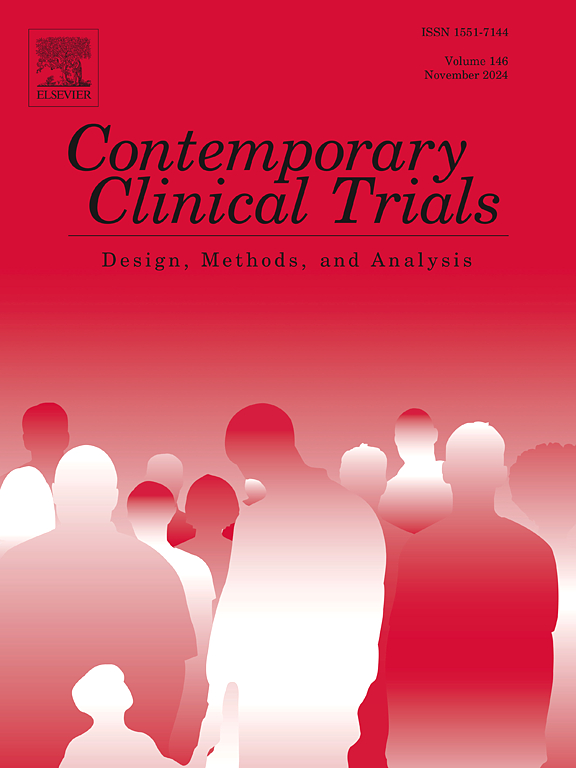美国精神疾病临床试验登记的性别差异
IF 1.9
3区 医学
Q3 MEDICINE, RESEARCH & EXPERIMENTAL
引用次数: 0
摘要
背景:临床试验入组的性别质量是检测治疗安全性和有效性的性别特异性差异的最佳选择。对于研究中的精神疾病的表现如何变化或与其他临床试验特征的相互作用,我们知之甚少。本研究评估了政府注册的精神药物临床试验在入组时的性别差异,并确定了与入组差异相关的试验特征。方法:本横断面研究评估了2000年至2024年在ClinicalTrials.gov上对两性开放的美国1-3期介入性药物试验按性别入组的10种精神疾病(共441项试验,63,254名参与者)。使用单样本Wilcoxon签名秩检验将入组比例与平价(男女各占50%)和比例性(性别特异性疾病患病率)预期进行比较。具有交互作用的双向方差分析分析了障碍和试验特征对入组的影响。结果在精神分裂症(26.6%女性对50.0%性别特异性患病率)、阿片类药物使用障碍(29.2%对49.4%)和创伤后应激障碍(36.2%对74.2%)的试验中,两种标准均发现女性代表性不足(p < 0.01)。饮食失调的男性比例明显偏低(男性患病率为18.4%,性别患病率为30.9%)。在针对注意缺陷多动障碍(女性<;2015 vs.≥2015:29.0% vs. 53.2%, p < 0.001)和酒精使用障碍(22.0% vs. 37.7%, p = 0.04)的新试验中,女性入组显著改善。结论在精神科药物临床试验中存在性别差异,在不同的研究领域,男性和女性受试者的比例不足。随着时间的推移,大多数疾病在改善代表性方面没有取得进展。不平等和不成比例的精神病患者可以从改善代表性的支持中受益。本文章由计算机程序翻译,如有差异,请以英文原文为准。
Sex differences in clinical trial enrollment in the United States across psychiatric disorders
Background
Equality in clinical trial enrollment by sex is optimal for detecting sex-specific differences in treatment safety and efficacy. Little is known about how representation may vary among psychiatric disorders under study or interact with other clinical trial features. This study assessed sex differences in enrollment for ClinicalTrials.gov-registered psychiatric drug clinical trials and identified trial characteristics associated with enrollment disparities.
Methods
This cross-sectional study assessed, for ten psychiatric disorders, enrollment by sex for US-based phase 1–3 interventional drug trials open to both sexes in ClinicalTrials.gov between 2000 and 2024 (441 total trials; 63,254 participants). Enrollment proportions were compared to parity (50 % each sex) and proportionality (sex-specific disease prevalence) expectations using one-sample Wilcoxon signed rank tests. Two-way ANOVA tests with interaction analyzed effects of disorder and trial characteristics on enrollment.
Results
Significant (p < 0.01) female underrepresentation by both standards was detected in trials for schizophrenia (26.6 % female vs. 50.0 % sex-specific prevalence), opioid use disorder (29.2 % vs. 49.4 %), and post-traumatic stress disorder (36.2 % vs. 74.2 %). Significant male underrepresentation was noted for eating disorders (18.4 % male vs. 30.9 % sex-specific prevalence). Female enrollment improved significantly in newer trials for attention deficit hyperactivity disorder (female <2015 vs. ≥ 2015: 29.0 % vs. 53.2 %, p < 0.001) and alcohol use disorder (22.0 % vs. 37.7 %, p = 0.04).
Conclusions
Enrollment disparities by sex were observed for psychiatric drug clinical trials, with male and female participants underrepresented in different areas of research. Most disorders have not demonstrated progress toward improving representation over time. Psychiatric disorders with unequal and disproportionate enrollment may benefit from support to improve representation.
求助全文
通过发布文献求助,成功后即可免费获取论文全文。
去求助
来源期刊
CiteScore
3.70
自引率
4.50%
发文量
281
审稿时长
44 days
期刊介绍:
Contemporary Clinical Trials is an international peer reviewed journal that publishes manuscripts pertaining to all aspects of clinical trials, including, but not limited to, design, conduct, analysis, regulation and ethics. Manuscripts submitted should appeal to a readership drawn from disciplines including medicine, biostatistics, epidemiology, computer science, management science, behavioural science, pharmaceutical science, and bioethics. Full-length papers and short communications not exceeding 1,500 words, as well as systemic reviews of clinical trials and methodologies will be published. Perspectives/commentaries on current issues and the impact of clinical trials on the practice of medicine and health policy are also welcome.

 求助内容:
求助内容: 应助结果提醒方式:
应助结果提醒方式:


